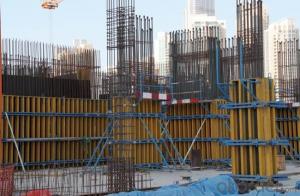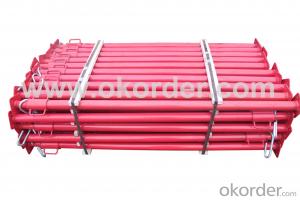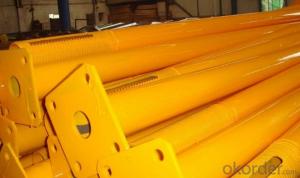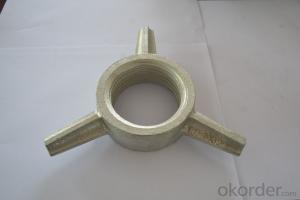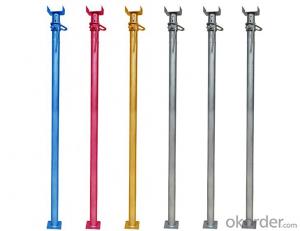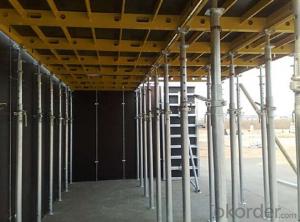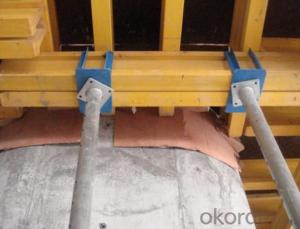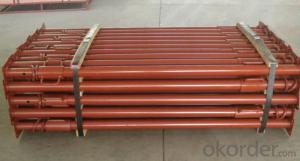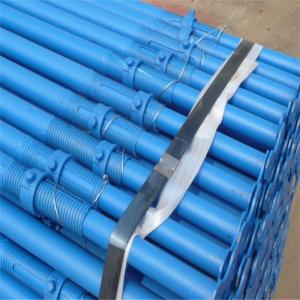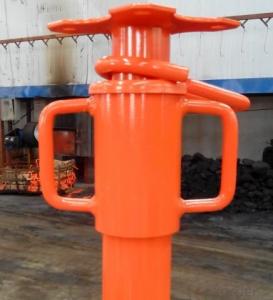Timber beam wall and column formwork
- Loading Port:
- China Main Port
- Payment Terms:
- TT OR LC
- Min Order Qty:
- -
- Supply Capability:
- -
OKorder Service Pledge
OKorder Financial Service
You Might Also Like
Timber beam wall formwork
Timber beam wall formwork is used for the concrete pouring of wall. The application oflarge areas formwork has greatly increased
the construction efficiency and reduced the cost. The system is convenient for construction and it is easy tocontrol the quality.
The system has two parts, formwork and pull-push props.The formwork is made of plywood, timber beam and steel waling. Pull-push props can be designed according to the project or simply select the standard props.Tie-yoke and tie rod are used to reinforce
the corner.


- Q:Are steel props adjustable for both vertical and horizontal loads?
- Typically, steel props cannot be adjusted to accommodate both vertical and horizontal loads. Steel props, also referred to as adjustable steel props or acrow props, are mainly created to offer vertical support and enhance stability to structures during construction or renovation projects. Their height can be adjusted, enabling them to be extended or retracted to suit various ceiling or floor heights. Nevertheless, they are not designed to withstand horizontal loads or provide lateral support. To handle horizontal loads, different structural elements like beams, columns, or bracing systems are employed.
- Q:How do you ensure proper alignment of steel props in a row?
- To ensure proper alignment of steel props in a row, several steps can be followed. Firstly, it is important to measure and mark the desired locations for the steel props. Accurate measurements and markings will help ensure that the props are evenly spaced and aligned in a straight row. Secondly, using a string line or laser level, establish a reference line to guide the alignment of the props. This reference line will act as a visual guide to ensure that the props are properly aligned. Next, carefully position each steel prop along the reference line, making sure they are all at the same height and securely placed. Adjustments may be needed to achieve the proper alignment, which can be done by adding or removing shims or using a leveling tool. Lastly, double-check the alignment of the props by visually inspecting the row from multiple angles. This will help ensure that all the props are in line and properly aligned before any weight or load is applied to them. By following these steps, one can ensure the proper alignment of steel props in a row, which is crucial for maintaining stability and safety in construction or support structures.
- Q:Can steel props be used in both indoor and outdoor environments?
- Yes, steel props can be used in both indoor and outdoor environments. Steel is a durable and strong material that can withstand various weather conditions, making it suitable for outdoor use. Additionally, steel props can also be used indoors for various construction and support purposes.
- Q:Are steel props environmentally friendly?
- Steel props are not considered environmentally friendly due to their high carbon footprint and energy-intensive production process. Steel production requires significant amounts of energy, releases large amounts of greenhouse gases, and contributes to deforestation and habitat destruction. Additionally, steel props are non-biodegradable, meaning they do not decompose and can contribute to waste accumulation if not properly recycled.
- Q:Can steel props be used in the construction of dams?
- Yes, steel props can be used in the construction of dams. Steel props, also known as steel supports or steel shoring, are commonly used in construction projects to provide temporary support to structures or excavations. In dam construction, steel props can be utilized during various stages of the project. During the excavation phase, steel props can be used to secure the sides of the excavation and prevent soil or rock collapse. This is crucial to ensure the safety of workers and maintain the stability of the site. Steel props can be adjusted and installed at different lengths to accommodate the specific requirements of the excavation. Additionally, steel props can also be used during the construction of the dam walls. They can be employed to support the formwork or molds used to shape the concrete walls of the dam. Steel props provide stability and strength to the formwork, allowing construction workers to pour and shape the concrete in a controlled manner. Moreover, steel props can be utilized during the maintenance or repair of dams. When certain sections of a dam need to be accessed for maintenance or repair work, steel props can be used to provide temporary support to the surrounding structures. This ensures the safety of workers and prevents any potential collapse or damage to the dam. Overall, steel props are versatile and reliable tools that can be effectively used in the construction of dams. They provide temporary support, stability, and safety, making them an essential component in the construction and maintenance of dams.
- Q:Can steel props be used in the construction of temporary parking structures?
- Yes, steel props can be used in the construction of temporary parking structures. Steel props, also known as steel shoring or temporary supports, are commonly used in construction projects to provide temporary support to structures. They are strong, durable, and capable of bearing heavy loads, making them suitable for temporary parking structures where stability and safety are crucial.
- Q:What are the maximum and minimum height adjustments for a steel prop?
- The maximum and minimum height adjustments for a steel prop can vary depending on its specific design and purpose. However, in general, steel props typically have a maximum height adjustment range of around 2.5 to 4 meters (8 to 13 feet) and a minimum height adjustment range of approximately 1.5 to 2 meters (5 to 6.5 feet).
- Q:How do you prevent steel props from sinking in wet soil?
- To prevent steel props from sinking in wet soil, there are a few strategies you can employ: 1. Increase the surface area: One effective method is to utilize larger steel plates or base plates at the bottom of the props. These plates should be wider than the props themselves, spreading the load over a larger area and reducing the risk of sinking. 2. Use adjustable props: Consider using adjustable steel props that can be extended or shortened as needed. This allows you to adjust the height of the props to accommodate the varying soil conditions, ensuring they remain stable and secure. 3. Add additional support: If the soil is extremely wet or unstable, it may be necessary to provide additional support to the steel props. This can be achieved by driving wooden or steel beams into the ground at an angle, creating a diagonal brace that provides extra stability. 4. Install a stable base: Prior to installing the props, it is crucial to prepare a stable base in the wet soil. This can be achieved by excavating the area and replacing the wet soil with a layer of compacted gravel or crushed stone. These materials provide a solid and stable foundation for the props. 5. Implement dewatering techniques: If the soil remains consistently wet, implementing dewatering techniques can help reduce the moisture content. This can be achieved through methods such as installing drainage pipes or using pumps to remove excess water from the area. By reducing the water content in the soil, you can improve its stability and prevent the steel props from sinking. Remember, it is essential to consult with a structural engineer or construction professional to assess the specific soil conditions and determine the most suitable solution to prevent steel props from sinking in wet soil.
- Q:How do you calculate the number of steel props required for a specific task?
- To determine the required number of steel props for a specific task, several factors need to be taken into consideration. These factors include the weight and size of the load to be supported, the distance between the props, and the strength and capacity of each individual prop. 1. Start by determining the weight and size of the load. This initial step will provide insight into the load-bearing capacity necessary for the steel props. 2. Next, determine the spacing between the props. This will depend on the load's size and weight distribution. It is important to ensure that the spacing provides sufficient support and stability for the load. 3. Verify the load capacity of the steel props. Manufacturers usually specify the load capacity of each prop. Check the load capacity of the existing props or those intended for purchase. This will help establish the maximum weight each prop can bear. 4. Calculate the required load-bearing capacity by dividing the total weight of the load by the load capacity of a single prop. This calculation will provide an estimate of the number of props needed to support the load. 5. Account for safety factors. It is crucial to incorporate safety margins when determining the number of steel props required. It is advisable to add one or two extra props to ensure additional support and accommodate any uncertainties or variations in load distribution. 6. Consider the type and quality of the props. Different types of steel props possess varying load-bearing capacities. Evaluate the type and quality of the props being used to ensure they meet the necessary safety standards and regulations. 7. Seek consultation from a structural engineer or an expert. If there is uncertainty or if the task involves complex load calculations, it is recommended to consult with a structural engineer or an expert in the field. They can provide guidance and assist in accurately calculating the required number of steel props. Always prioritize safety and adhere to relevant regulations and guidelines when calculating the number of steel props required for a specific task.
- Q:Scaffolding steel pipe support spacing
- Open type double row steel pipe scaffolding pole spacing 1.05, 1.30, 1.55M.Open type single row steel pipe scaffolding pole spacing 1.20, 1.40M.
1. Manufacturer Overview |
|
|---|---|
| Location | |
| Year Established | |
| Annual Output Value | |
| Main Markets | |
| Company Certifications | |
2. Manufacturer Certificates |
|
|---|---|
| a) Certification Name | |
| Range | |
| Reference | |
| Validity Period | |
3. Manufacturer Capability |
|
|---|---|
| a)Trade Capacity | |
| Nearest Port | |
| Export Percentage | |
| No.of Employees in Trade Department | |
| Language Spoken: | |
| b)Factory Information | |
| Factory Size: | |
| No. of Production Lines | |
| Contract Manufacturing | |
| Product Price Range | |
Send your message to us
Timber beam wall and column formwork
- Loading Port:
- China Main Port
- Payment Terms:
- TT OR LC
- Min Order Qty:
- -
- Supply Capability:
- -
OKorder Service Pledge
OKorder Financial Service
Similar products
New products
Hot products
Hot Searches
Related keywords
